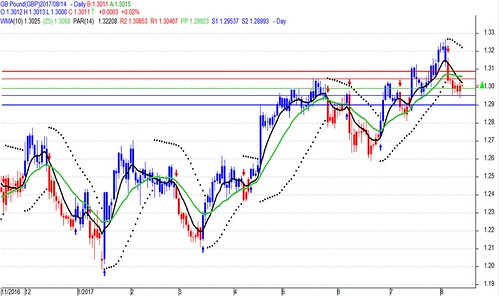Enge, may be used to predict whether an MedChemExpress Pentagastrin animal will survive. Thus, 1379592 the data suggest that the total number of thrombocytes and lymphocytes influence survival when ferrets are infected with HPAI. Moreover, maintaining body weight and mean corpuscular volume [(MCV) average RBC volume], three days post-infection, may lead to a greater chance of survival (Table 1). HPAI-infected animals show signs of anorexia and begin to lose weight. However, the data suggest that maintaining body weight correlates with survival of the animal, which is a typical correlation associated with most disease states. Statistical analyses of these parameters show significant correlation with survival in the HPAI survival model since the positive slope estimate suggests that if there is a smaller decrease from baseline for a representative parameter, then the animal has a greater probability of surviving infection. Severe human disease due to influenza virus infection results in lymphopenia, leucopenia, fever, anemia, and changes in clinical pathology. Complete analyses of clinical chemistry profiles in humans infected with swine influenza have been described [15] and the observed changes in this current study add credence to the ferret model. Though many changes to the host system, as a result of influenza virus infection, have been observed, a statistical comparison using data from multiple studies on signs of diseaseTable 1.  Correlates of Survival in HPAI-Infected Ferrets.Parameter Decrease in Lymphocytes Change in MCV Decrease in PLTDays of PostChallenge 3 3Slope 3.65 97.7 20.7 0.P-Value 0.04 0.04 0.02 0.Decrease in Body 5 Weight doi:10.1371/journal.pone.0058337.tand changes associated with body temperature, clinical pathology, and virus shedding has not been reported. Thus, this study aimed to describe the clinical profile associated with disease in ferrets caused by the various influenza viruses and to determine whether correlates of protection could be identified. The identification of such correlates of protection could shape the strategic targets of novel therapeutics and prophylaxis. For example, statistical analyses of the data presented here suggest that the survival of ferrets infected with various influenza viruses exhibited greater lymphocyte numbers, less change in MCV, higher platelet numbers, and overall higher body weights. Individually, these parameters may not affect the survival of a ferret infected with influenza viruses. However, collectively, these parameters have been statistically identified as correlates of protection and thus, may represent targets for novel therapeutics and prophylaxis. In conclusion, establishing the clinical profile or disease signature associated with influenza disease is necessary to establish correlates of protection. Previous published work has suggested that virulence factors and mortality associated with various influenza viruses may correlate with several host and viral factors including: the presence of influenza receptors on cells; temperature changes; induction of cellular necrosis; viremia and viral titers in host tissues; and the induction of a severe immune response [12?14]. Our study suggests that the severity and duration of febrile temperatures, overall lymphocyte and platelet numbers, changes in MCV, and overall body weight associated with the host animal after influenza infection may also have a role in the pathogenesis and disease state, which may serve as correlates of clinical disease in order CP21
Correlates of Survival in HPAI-Infected Ferrets.Parameter Decrease in Lymphocytes Change in MCV Decrease in PLTDays of PostChallenge 3 3Slope 3.65 97.7 20.7 0.P-Value 0.04 0.04 0.02 0.Decrease in Body 5 Weight doi:10.1371/journal.pone.0058337.tand changes associated with body temperature, clinical pathology, and virus shedding has not been reported. Thus, this study aimed to describe the clinical profile associated with disease in ferrets caused by the various influenza viruses and to determine whether correlates of protection could be identified. The identification of such correlates of protection could shape the strategic targets of novel therapeutics and prophylaxis. For example, statistical analyses of the data presented here suggest that the survival of ferrets infected with various influenza viruses exhibited greater lymphocyte numbers, less change in MCV, higher platelet numbers, and overall higher body weights. Individually, these parameters may not affect the survival of a ferret infected with influenza viruses. However, collectively, these parameters have been statistically identified as correlates of protection and thus, may represent targets for novel therapeutics and prophylaxis. In conclusion, establishing the clinical profile or disease signature associated with influenza disease is necessary to establish correlates of protection. Previous published work has suggested that virulence factors and mortality associated with various influenza viruses may correlate with several host and viral factors including: the presence of influenza receptors on cells; temperature changes; induction of cellular necrosis; viremia and viral titers in host tissues; and the induction of a severe immune response [12?14]. Our study suggests that the severity and duration of febrile temperatures, overall lymphocyte and platelet numbers, changes in MCV, and overall body weight associated with the host animal after influenza infection may also have a role in the pathogenesis and disease state, which may serve as correlates of clinical disease in order CP21  ferrts. F.Enge, may be used to predict whether an animal will survive. Thus, 1379592 the data suggest that the total number of thrombocytes and lymphocytes influence survival when ferrets are infected with HPAI. Moreover, maintaining body weight and mean corpuscular volume [(MCV) average RBC volume], three days post-infection, may lead to a greater chance of survival (Table 1). HPAI-infected animals show signs of anorexia and begin to lose weight. However, the data suggest that maintaining body weight correlates with survival of the animal, which is a typical correlation associated with most disease states. Statistical analyses of these parameters show significant correlation with survival in the HPAI survival model since the positive slope estimate suggests that if there is a smaller decrease from baseline for a representative parameter, then the animal has a greater probability of surviving infection. Severe human disease due to influenza virus infection results in lymphopenia, leucopenia, fever, anemia, and changes in clinical pathology. Complete analyses of clinical chemistry profiles in humans infected with swine influenza have been described [15] and the observed changes in this current study add credence to the ferret model. Though many changes to the host system, as a result of influenza virus infection, have been observed, a statistical comparison using data from multiple studies on signs of diseaseTable 1. Correlates of Survival in HPAI-Infected Ferrets.Parameter Decrease in Lymphocytes Change in MCV Decrease in PLTDays of PostChallenge 3 3Slope 3.65 97.7 20.7 0.P-Value 0.04 0.04 0.02 0.Decrease in Body 5 Weight doi:10.1371/journal.pone.0058337.tand changes associated with body temperature, clinical pathology, and virus shedding has not been reported. Thus, this study aimed to describe the clinical profile associated with disease in ferrets caused by the various influenza viruses and to determine whether correlates of protection could be identified. The identification of such correlates of protection could shape the strategic targets of novel therapeutics and prophylaxis. For example, statistical analyses of the data presented here suggest that the survival of ferrets infected with various influenza viruses exhibited greater lymphocyte numbers, less change in MCV, higher platelet numbers, and overall higher body weights. Individually, these parameters may not affect the survival of a ferret infected with influenza viruses. However, collectively, these parameters have been statistically identified as correlates of protection and thus, may represent targets for novel therapeutics and prophylaxis. In conclusion, establishing the clinical profile or disease signature associated with influenza disease is necessary to establish correlates of protection. Previous published work has suggested that virulence factors and mortality associated with various influenza viruses may correlate with several host and viral factors including: the presence of influenza receptors on cells; temperature changes; induction of cellular necrosis; viremia and viral titers in host tissues; and the induction of a severe immune response [12?14]. Our study suggests that the severity and duration of febrile temperatures, overall lymphocyte and platelet numbers, changes in MCV, and overall body weight associated with the host animal after influenza infection may also have a role in the pathogenesis and disease state, which may serve as correlates of clinical disease in ferrts. F.
ferrts. F.Enge, may be used to predict whether an animal will survive. Thus, 1379592 the data suggest that the total number of thrombocytes and lymphocytes influence survival when ferrets are infected with HPAI. Moreover, maintaining body weight and mean corpuscular volume [(MCV) average RBC volume], three days post-infection, may lead to a greater chance of survival (Table 1). HPAI-infected animals show signs of anorexia and begin to lose weight. However, the data suggest that maintaining body weight correlates with survival of the animal, which is a typical correlation associated with most disease states. Statistical analyses of these parameters show significant correlation with survival in the HPAI survival model since the positive slope estimate suggests that if there is a smaller decrease from baseline for a representative parameter, then the animal has a greater probability of surviving infection. Severe human disease due to influenza virus infection results in lymphopenia, leucopenia, fever, anemia, and changes in clinical pathology. Complete analyses of clinical chemistry profiles in humans infected with swine influenza have been described [15] and the observed changes in this current study add credence to the ferret model. Though many changes to the host system, as a result of influenza virus infection, have been observed, a statistical comparison using data from multiple studies on signs of diseaseTable 1. Correlates of Survival in HPAI-Infected Ferrets.Parameter Decrease in Lymphocytes Change in MCV Decrease in PLTDays of PostChallenge 3 3Slope 3.65 97.7 20.7 0.P-Value 0.04 0.04 0.02 0.Decrease in Body 5 Weight doi:10.1371/journal.pone.0058337.tand changes associated with body temperature, clinical pathology, and virus shedding has not been reported. Thus, this study aimed to describe the clinical profile associated with disease in ferrets caused by the various influenza viruses and to determine whether correlates of protection could be identified. The identification of such correlates of protection could shape the strategic targets of novel therapeutics and prophylaxis. For example, statistical analyses of the data presented here suggest that the survival of ferrets infected with various influenza viruses exhibited greater lymphocyte numbers, less change in MCV, higher platelet numbers, and overall higher body weights. Individually, these parameters may not affect the survival of a ferret infected with influenza viruses. However, collectively, these parameters have been statistically identified as correlates of protection and thus, may represent targets for novel therapeutics and prophylaxis. In conclusion, establishing the clinical profile or disease signature associated with influenza disease is necessary to establish correlates of protection. Previous published work has suggested that virulence factors and mortality associated with various influenza viruses may correlate with several host and viral factors including: the presence of influenza receptors on cells; temperature changes; induction of cellular necrosis; viremia and viral titers in host tissues; and the induction of a severe immune response [12?14]. Our study suggests that the severity and duration of febrile temperatures, overall lymphocyte and platelet numbers, changes in MCV, and overall body weight associated with the host animal after influenza infection may also have a role in the pathogenesis and disease state, which may serve as correlates of clinical disease in ferrts. F.